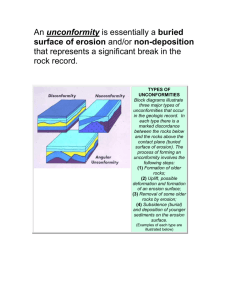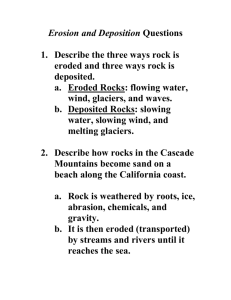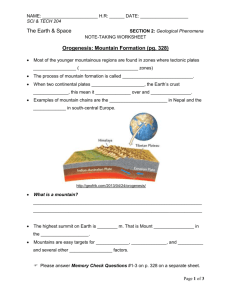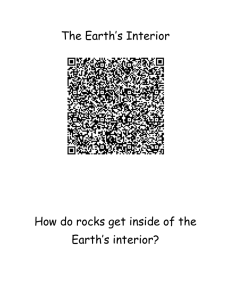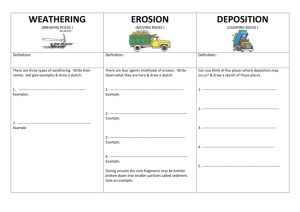Erosion: the Game - Division/Area Menu
advertisement
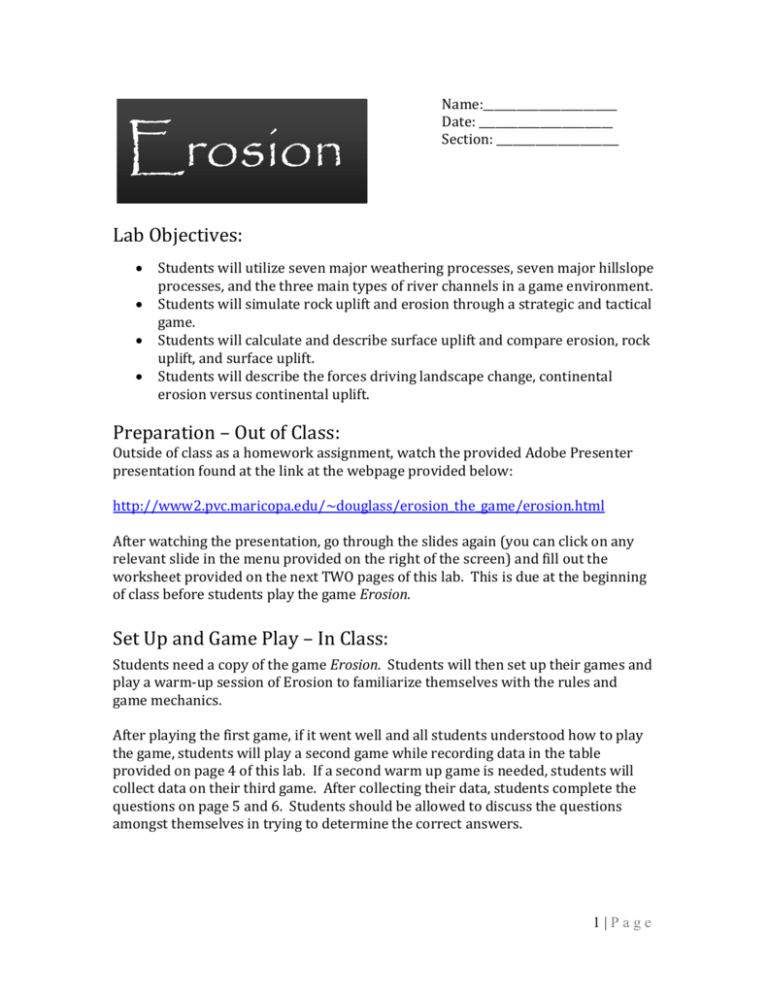
Erosion Name:________________________ Date: ________________________ Section: ______________________ Lab Objectives: Students will utilize seven major weathering processes, seven major hillslope processes, and the three main types of river channels in a game environment. Students will simulate rock uplift and erosion through a strategic and tactical game. Students will calculate and describe surface uplift and compare erosion, rock uplift, and surface uplift. Students will describe the forces driving landscape change, continental erosion versus continental uplift. Preparation – Out of Class: Outside of class as a homework assignment, watch the provided Adobe Presenter presentation found at the link at the webpage provided below: http://www2.pvc.maricopa.edu/~douglass/erosion_the_game/erosion.html After watching the presentation, go through the slides again (you can click on any relevant slide in the menu provided on the right of the screen) and fill out the worksheet provided on the next TWO pages of this lab. This is due at the beginning of class before students play the game Erosion. Set Up and Game Play – In Class: Students need a copy of the game Erosion. Students will then set up their games and play a warm-up session of Erosion to familiarize themselves with the rules and game mechanics. After playing the first game, if it went well and all students understood how to play the game, students will play a second game while recording data in the table provided on page 4 of this lab. If a second warm up game is needed, students will collect data on their third game. After collecting their data, students complete the questions on page 5 and 6. Students should be allowed to discuss the questions amongst themselves in trying to determine the correct answers. 1|Page Erosion Presentation Homework Worksheet 1. The game Erosion simulates the struggle between orogeny (mountain building) and erosion. What processes drive orogeny? 2. What processes drive erosion? 3. While playing the game, a player is in control of three distinct card locations in their own player area: Mountain, Delta, and Discards. Describe the function of these three distinct card locations? 4. How many and what type of cards make up a player’s hand at the beginning of the game? 5. When rock is weathered on a player’s mountain, how is this shown in the game? What if all the rocks on a mountain are weathered? 6. Where is the “river” located during game play? Do all players have access to the river? 7. How are weathered cards transported to the river during game play? 2|Page 8. Fluvial processes are the trickiest part of game play. When a player discards a fluvial card to transport a rock card from the river into their delta, what else must they discard? 9. When can a player uplift their own mountain, and how many cards can they uplift? 10. When will the game end? 11. How many points does a player earn if a rock card with a fossil on it is weathered on their mountain at the end of the game? 12. How many points does a player earn for each rock card in their delta? 13. How many points does a player earn for each weathered rock card in their mountain? How many points for each un-weathered rock in their mountain? 3|Page Erosion Data Sheet – Data collection during game play: During each round where each player has a chance to play a weathering, hillslope, or fluvial card, and each player has a chance to uplift their mountain; record in the table below what happens to YOUR mountain and YOUR delta. After the game, calculate totals, averages, and rates in the data table below. Don’t forget to record the end of game data in the chart on the right. Game Round: Example Rocks Weathered Rocks Hillslope 2 3 Rocks Delta 0 Rocks Uplifted 4 End of Game Data # of fresh rocks on your mountain? 1 2 3 4 5 6 7 8 Total # of WX rocks on your mountain? # of rocks in the collective river? Average (Total / # of Rounds) Rocks Weathered Rocks Hillslope Rocks Delta Rocks Uplifted Calculations Rocks Uplifted average / 2 = (Uplift) Rocks Hillsloped average / 2 = (Erosion) Surface Uplift # of rocks in all deltas kilometers³ every million years Rock uplift rate – Hillslope (Erosion) rate = Depositional rate kilometers³ every million years km³ / Ma rate # rocks uplifted on all mountains # rocks in all deltas / # rounds / 2 = km³ / Ma rate All mountains rock uplift rate # rocks uplifted on all mountains / # rounds / 2 Orogeny versus Erosion All Mountains rock uplift rate - Depositional rate = = km³ / Ma rate km³ / Ma rate 4|Page Erosion Data Questions: 1. Who won the game and what strategy did they use to win (mountain, delta, fossil, or some combination)? 2. Describe as best you can the difference between the Hillslope (Erosion) rate, Rock Uplift Rate, and Surface Uplift Rate (look at your data sheet)? 3. How does your mountain’s surface uplift rate compare to other mountains and continental surfaces in the world (circle the appropriate location)? Wichita Mts. Midwest U.S. -0.15 km / Ma Flinders Range Australia 0.03 km / Ma Banda-Arc Mts. Indonesia 0.3 km / Ma Finisterre Mts. New Guinea 0.8 km / Ma Himalayan Mts. Asia 1.2 km / Ma 4. The “Orogeny versus Erosion” rate you calculated is either positive or negative. If orogeny is winning the rate is positive, and if erosion is winning the rate is negative. What is the implication for a continent where orogeny is winning? 5. The number of rocks in the river at the end of the game suggests what kind of climate dominated your mountains. If the river is clogged with sediment, the climate could be dry, why is this? 6. If the climate is wet, but the river is still clogged with sediment, the rock uplift rate and the erosion rate must be extreme, why is this? 7. Would you like to live under a mountain that experiences rare landslide events or a mountain with roughly constant weathering and erosion rates, why? 5|Page 8. If mountain building shutdown worldwide, what would eventually happen to the surface of the world’s continents? What if the hydrologic cycle shutdown? 9. How has playing this game changed your thinking about this mountain range? 10. Has playing this game changed how you think about Earth’s landforms? How? 6|Page
